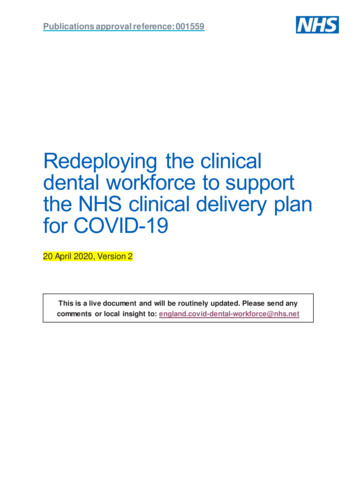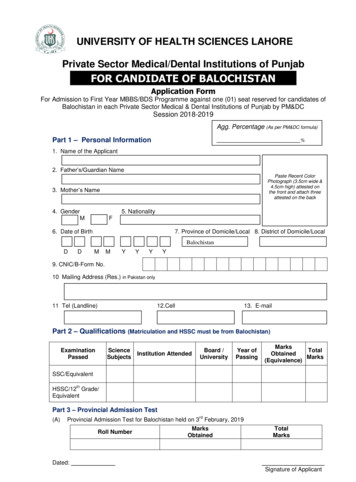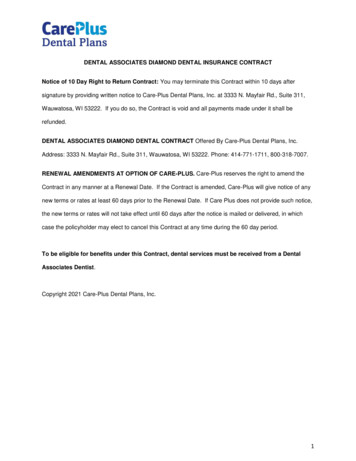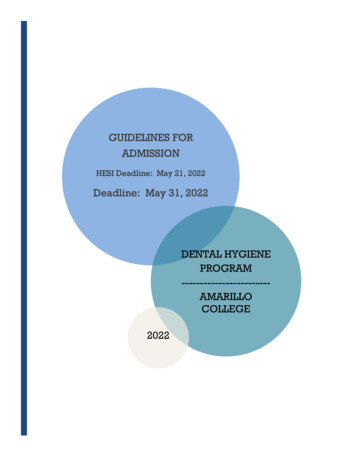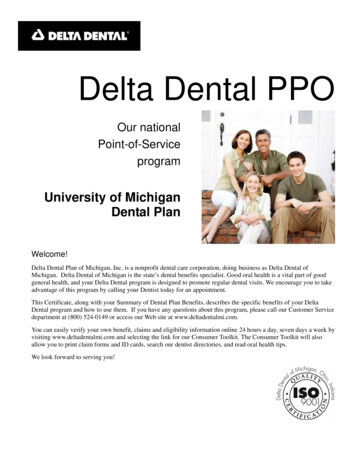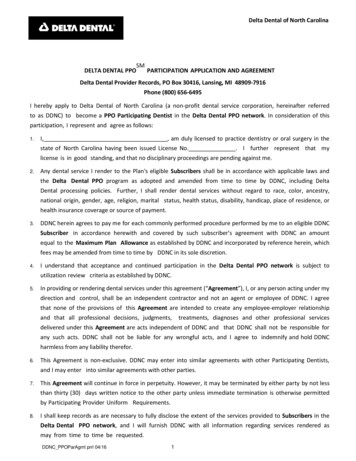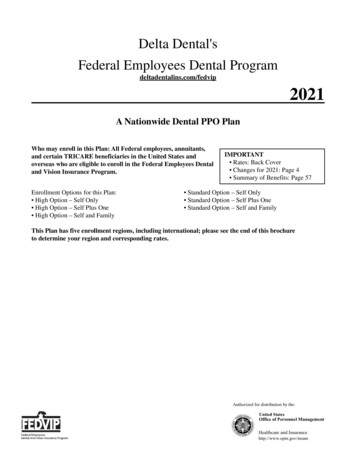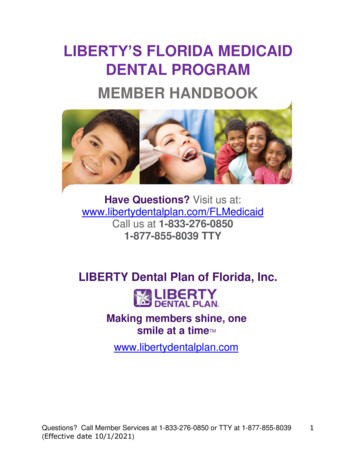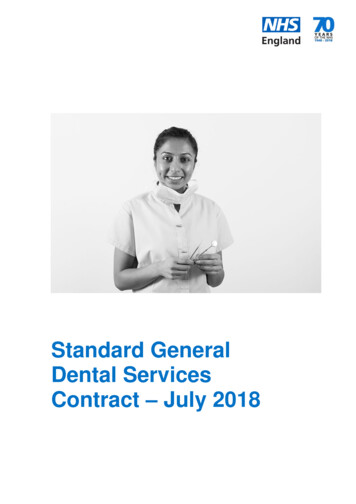
Transcription
Standard GeneralDental ServicesContract – July 2018
OFFICIALNHS England INFORMATION READER BOXDirectorateMedicalNursingFinanceOperations and InformationTrans. & Corp. Ops.Publications Gateway Reference:Specialised CommissioningStrategy & Innovation08311Document PurposeOther (see Description)Document NameGeneral Dental Services Model Contract 2018AuthorNHS EnglandPublication Date23rd July 2018Target AudienceNHS England Regional Directors, NHS England Directors ofCommissioning Operations, Directors of Commissioning, Heads ofPrimary Care, Dental LeadsAdditional CirculationListNHS England Regional Directors, NHS England Directors ofCommissioning OperationsDescriptionThis is a Model GDS contract for use by Dental Commissioners in localteamsCross ReferenceSuperseded Docs(if applicable)Action RequiredTiming / Deadlines(if applicable)Contact Details forfurther informationN/AN/AFor use by Commissioners of Primary Care Dental ServicesN/ADavid RobertsArea 3A, 3rd floorSkipton House80 London RoadLondonSE1 6LHengland.primarycareops@nhs.netDocument StatusThis is a controlled document. Whilst this document may be printed, the electronic version posted onthe intranet is the controlled copy. Any printed copies of this document are not controlled. As acontrolled document, this document should not be saved onto local or network drives but shouldalways be accessed from the intranet.2
OFFICIALStandard General Dental Services Contract July 2018Version number:1First published:April 2006Updated:July 2018Prepared by:Operations and Information DirectorateClassification:(OFFICIAL)The National Health Service Commissioning Board was established on 1 October2012 as an executive non-departmental public body. Since 1 April 2013, the NationalHealth Service Commissioning Board has used the name NHS England foroperational purposesThis information can be made available in alternative formats, such as easyread or large print, and may be available in alternative languages, uponrequest. Please contact 0300 311 22 33 or email england.contactus@nhs.netstating that this document is owned by the Operations and InformationDirectorate.3
OFFICIALContentsContents . 4PART 1DEFINITIONS AND INTERPRETATION . 7PART 2RELATIONSHIP BETWEEN THE PARTIES . 22PART 3NHS CONTRACT . 24PART 4COMMENCEMENT OF THE CONTRACT . 25PART 5WARRANTIES . 26PART 6PATIENTS . 28PART 7LEVEL OF SKILL . 34PART 8MANDATORY SERVICES . 44PART 9ADDITIONAL SERVICES. 52PART 10FURTHER SERVICES . 69PART 11SUPPLY OF DRUGS AND PRESCRIBING . 70PART 12PERSONS WHO PERFORM SERVICES . 72PART 13RECORDS, INFORMATION, NOTIFICATIONS AND RIGHT OF ENTRY79PART 14PAYMENT UNDER THE CONTRACT . 92PART 15FEES, CHARGES AND FINANCIAL INTERESTS OF THECONTRACTOR . 94PART 16CLINICAL GOVERNANCE AND QUALITY ASSURANCE . 96PART 17INSURANCE . 98PART 18GIFTS . 99PART 19COMPLIANCE WITH LEGISLATION AND GUIDANCE . 102PART 20COMPLAINTS. 103PART 21DISPUTE RESOLUTION . 106PART 22VARIATION AND TERMINATION OF THE CONTRACT . 109PART 23EVIDENCE. 136NON-SURVIVAL OF TERMS . 136ENTIRE AGREEMENT. 137GOVERNING LAW AND JURISDICTION . 137WAIVER, DELAY OR FAILURE TO EXERCISE RIGHTS. 138FORCE MAJEURE . 138SEVERANCE . 139SERVICE OF NOTICE . 1404
OFFICIALPART 24SIGNING OF DOCUMENTS . 142SCHEDULE 1 (INDIVIDUAL) . 143SCHEDULE 1 (PARTNERSHIP) . 144SCHEDULE 1 (DENTAL CORPORATION) . 146SCHEDULE 1 (LIMITED LIABILITY PARTNERSHIP) . 147SCHEDULE 2 (SIGNATURES OF THE PARTIES TO THE CONTRACT). 148SCHEDULE 3 (INFORMATION TO BE INCLUDED IN A PATIENT INFORMATIONLEAFLET) . 149SCHEDULE 4 (PAYMENT SCHEDULE) . 1515
OFFICIALTHIS CONTRACT is made on theday of20[]BETWEEN(1) The National Health Service Commissioning Board whose name and addressappears at Schedule 1 to this Contract (called “the Board”) and(2) The contractor(s) whose name(s) appear(s) at Schedule 1 to this Contract(called “the Contractor”)BACKGROUNDA. The Board is a statutory body established by order made pursuant to section1H of the National Health Service Act 2006. It is the duty of the Board toexercise its powers so as to secure the provision of primary dental servicesthroughout England.B. In order to achieve this object, the Board is empowered by Part 5 of theNational Health Service Act 2006, and the regulations made thereunder1, toenter into a general dental services contract with specified categories ofperson.C. By virtue of a property transfer scheme made under section 300 of the Healthand Social Care Act 2012, a general dental services contract which wasentered into before 1st April 2013 is to transfer to the Board on that date.D. The Contractor falls within one of the specified categories of person.E. The Board and the Contractor wish to enter into a general dental servicescontract under which the Contractor is to provide primary dental services [andother services]2 in accordance with the provisions of this Contract.3The National Health Service (General Dental Services Contracts) Regulations 2005.Delete the words in square brackets if only primary dental services are to be provided under theContract.3 For the avoidance of doubt, the Contract should not be used in relation to Prototype Agreements.126
OFFICIALPART 1DEFINITIONS AND INTERPRETATION1. The following terms and phrases shall have the following meanings for thepurposes of this Contract:“the 1977 Act” means the National Health Service Act 1977;“the 2006 Act” means the National Health Service Act 2006;“additional services” means one or more of—(a) advanced mandatory services,(b) dental public health services,(c) domiciliary services,(d) orthodontic services, and(e) sedation services;“adjudicator” means the Secretary of State or a person or persons appointed bythe Secretary of State under section 9(8) of the 2006 Act or paragraph 55(4) ofSchedule 3 to the Regulations;“advanced mandatory services” means any primary dental service that would fallwithin the services described in clauses 74 to 76, but by virtue of the high level offacilities, experience or expertise required in respect of a particular patient, theservice is provided as a referral service;"appropriate cover" means cover against liabilities that may be incurred by theContractor in the performance of clinical services under the Contract, which isappropriate, having regard to the nature and extent of the risks in theperformance of such services;“Band 1 course of treatment” means a course of treatment, including a course oftreatment consisting of urgent treatment, provided to a patient in respect of which7
OFFICIALa Band 1 NHS Charge is payable pursuant to the NHS Charges Regulations, orwould be payable if the patient was not an exempt person;“Band 2 course of treatment” means a course of treatment provided to a patient inrespect of which a Band 2 NHS Charge is payable pursuant to the NHS ChargesRegulations, or would be payable if the patient was not an exempt person;“Band 3 course of treatment” means a course of treatment provided to a patient inrespect of which a Band 3 NHS Charge is payable pursuant to the NHS ChargesRegulations, or would be payable if the patient was not an exempt person;“banded course of treatment” means a Band 1, Band 2 or Band 3 course oftreatment;“bank holiday” means any day that is specified or proclaimed as a bank holiday inEngland pursuant to section 1 of the Banking and Financial Dealings Act 1971;“bridge” means a fixed or removable bridge which takes the place of any teeth;“Care Quality Commission” means the body established by section 1 of theHealth and Social Care Act 2008 (The Care Quality Commission);“case assessment”, in respect of an orthodontic course of treatment, means aclinical examination of the patient, including the taking of such radiographs, colourphotographs and models as are required in order to determine what orthodontictreatment (if any) is to be provided to the patient;“charge exempt course of treatment” means a course of treatment that involvesthe examination and assessment of a patient leading to—(a) the issue of a prescription,(b) the repair of a dental appliance,(c) the arrest of bleeding, or(d) the removal of sutures,8
OFFICIALwhich, by virtue of regulation 3(2)(d) or (e) of the NHS Charges Regulations, isprovided free of charge to the patient;“charity trustee” means one of the persons having the general control andmanagement of the administration of a charity;“child” means a person who has not attained the age of 16 years;“clinical governance arrangements” means arrangements through which theContractor endeavours to continuously improve the quality of its services andsafeguard high standards of care by creating an environment in which clinicalexcellence can flourish;“complete”, in relation to—(a) a course of treatment, means that—(i)where no treatment plan has to be provided in respect of a trecommended to, and agreed with, the patient by the Contractor atthe initial examination and assessment of that patient has beenprovided to the patient; or(ii)where a treatment plan has to be provided to the patient pursuantto clause 47, all the treatment specified on that plan by theContractor (or that plan as revised in accordance with clause 49)has been provided to the patient, and(b) an orthodontic course of treatment, means that—(i)where the Contractor determines in accordance with clause 144that no orthodontic treatment should be provided following thecase assessment, the completion of the case assessment; or9
OFFICIAL(ii)where the Contractor has determined that orthodontic treatmentshould be provided following the case assessment, all of theorthodontic treatment specified on the orthodontic treatment planby the Contractor pursuant to clause 151 (or that plan as revisedin accordance with clause 153) has been provided to the patient,and “completed” shall be construed accordingly;“Contract” means this Contract which is made under section 100 of the 2006Act between the Board and the Contractor named in Schedule 1;“course of treatment” means—(a) an examination of a patient, an assessment of that patient's oral health,and the planning of any treatment to be provided to that patient as a resultof that examination and assessment,(b) the provision of any planned treatment (including any treatment planned ata time other than the time of the initial examination) to that patient up tothe date on which(i) each and every component of the planned treatment has been providedto the patient, or(ii) the patient either voluntarily withdraws from, or is withdrawn by theprovider from treatment,by, unless the context otherwise requires, one or more providers ofprimary dental services, but except that it does not include the provision ofany orthodontic services or dental public health services;“dental appliance” means a denture or bridge and for the purposes of thisdefinition, a denture includes an obturator;“dental care professional” means a person whose name is included in theregister of dental care professionals or on the appropriate roll for dentalauxiliaries established in accordance with Part II of the Dental AuxiliariesRegulations 1986;10
OFFICIAL“dental corporation” means a body corporate carrying on the business ofdentistry in accordance with the Dentists Act;“dental performers list” means the list of dental practitioners maintained by theBoard in accordance with regulations made under section 106 of the 2006 Act;“dental public health services” means services provided by the Contractor byvirtue of section 111(2)(c) of the 2006 Act;“Dentists Act” means the Dentists Act 1984;“Dentists Act Order” means the Dentists Act 1984 (Amendment) Order 2005;“Dentists Register” means the register maintained by the General DentalCouncil pursuant to section 14 of the Dentists Act;“domiciliary services” means a course of treatment, or part of a course oftreatment, provided at a location other than—(a) the practice premises of any provider of primary dental services,(b) a mobile surgery of any provider of primary dental services, or(c) a prison;"electronic submission" means the submission of information electronically viaa computer system approved by the Board;“exempt person” means a person who is, by virtue of either section 177 of the2006 Act or the NHS Charges Regulations, exempt from the need to pay anNHS Charge in respect of the services he has received under the Contract;“family member” means—(a) a spouse,(b) a civil partner,11
OFFICIAL(c) a person whose relationship with the patient has the characteristics of therelationship between husband and wife or civil partners,(d) a parent or step-parent,(e) a son,(f) a daughter,(g) a child of whom the person is—(i) the guardian, or(ii) the carer duly authorised by the local authority to whose care the child hasbeen committed under the Children Act 1989, or(h) a grandparent;“FHSAA” means the Family Health Services Appeal Authority constituted undersection 49S of the 1977 Act;“financial year” means a period of 12 months ending with 31st March in any year;"Friends and Family Test" means the arrangements that the Contractor isrequired by the Board to implement to enable its patients to provide anonymousfeedback about the patient experience at the Contractor's practice;“health care professional” has the same meaning as in section 102 of the 2006Act and “health care profession” shall be construed accordingly;“health service body” has, unless the context otherwise requires, the meaninggiven to it in section 9(4) of the 2006 Act;“Health Service Commissioner” means the person appointed Health ServiceCommissioner for England in accordance with section 1 of, and Schedule 1 to,the Health Service Commissioners Act 1993;“indemnity arrangement” means a contract of insurance or other arrangementmade for the purpose of indemnifying the Contractor;“licensing body” means any body that licenses or regulates any profession;12
OFFICIAL“listed”, in relation to drugs, medicines or appliances, means such drugs,medicines or appliances as are included in a list for the time being approved bythe Secretary of State for the purposes of section 126(3)(c) of the 2006 Act;“local authority” means any of the bodies listed in section 1 of the Local AuthoritySocial Services Act 1970, the Council of the Isles of Scilly or a council constitutedunder section 2 of the Local Government etc. (Scotland) Act 1994;“mandatory services” means the services described in clauses 74 to 76;“mandatory term” means a term required to be included in the Contract by theRegulations;“mobile surgery”, except where expressly provided otherwise in the Contract,means any vehicle in which services under the Contract are to be provided;“national disqualification” means—(a) a decision made by the First-tier Tribunal under section 159 of the 2006Act or under regulations corresponding to that section made under section106(3) of the 2006 Act,(b) a decision under provisions in force in Scotland or Northern Irelandcorresponding to section 159 of the 2006 Act, or(c) a decision by the NHS Tribunal which is treated as a nationaldisqualification by the FHSAA by virtue of regulation 6(4)(b) of theAbolition of the National Health Service Tribunal (ConsequentialProvisions) Regulations 2001 or regulation 6(4)(b) of the Abolition of theNational Health Service Tribunal (Consequential Provisions) Regulations2002;“NHS body” means the Board, an NHS trust, an NHS foundation trust, a LocalHealth Board, a Health Board, a Health and Social Services Board, a Healthand Social Services Trust or, a Health Board or Special Health Board13
OFFICIALconstituted under section 2 of the National Health Service (Scotland) Act1978;“NHS Charge” means a charge made to the patient for provision of servicespursuant to the NHS Charges Regulations;“NHS Charges Regulations” means the National Health Service (DentalCharges) Regulations 2005 (as amended);“NHS contract” has the meaning assigned to it in section 9(1) of the 2006 Act;“NHS dispute resolution procedure” means the procedure for disputesspecified in Part 21;“NHS Tribunal” means the Tribunal constituted under section 46 of the 1977Act for England and Wales, and which, except for prescribed cases, had effectin relation to England only until 14th December 2001 and in relation to Walesonly until 26th August 2002;“normal surgery hours” means the times at which the Contractor has agreedwith the Board (and specified in the Contract) that the surgery will be open topatients for the provision of services;“orthodontic appliance” means a device used in the mouth to move orimmobilise the teeth in order to correct or prevent malocclusion;“orthodontic course of treatment” means—(a) a case assessment of a patient, and(b) the provision of any orthodontic treatment that the Contractor determinesshould be provided to the patient in accordance with clauses 142 to 163;“orthodontic services” means the provision of orthodontic courses of treatment orthe services referred to in clause 146;14
OFFICIAL“orthodontic treatment” means treatment of, or treatment to prevent, malocclusionof the teeth and jaws, and irregularities of the teeth;“parent”, in relation to any child, means a parent or other person who has parentalresponsibility for that child;“patient” means a person to whom the Contractor is providing services under theContract;“patient record” means a form supplied by the Board for the purpose ofmaintaining a record of treatment;“personal number” means a telephone number which starts with the number 070followed by a further 8 digits;“practice” means the business operated by the Contractor for the purpose ofdelivering services under the Contract;“practice premises”, except where expressly provided otherwise in the Contract,means an address specified in the Contract as one at which services are to beprovided under the Contract but does not include a mobile surgery;“prescriber” means a dental practitioner who is either engaged or employed bythe Contractor or is a party to the Contract;“prescription form” means a form that is supplied by the Board for the purposes ofclauses 175 and 176;“primary care list” means (a) a list of persons performing primary medical services, primary ophthalmicservices or dental services under sections 91, 106 or 123 of the 2006 Act,15
OFFICIAL(b) a list of persons undertaking to provide general ophthalmic services or, asthe case may be, pharmaceutical services prepared in accordance withregulations made under section 39, 42 or 43 of the 1977Act,(c) a list of persons approved for the purposes of assisting in the provision ofany services mentioned in paragraph (b) or (d) prepared in accordancewith regulations made under section 147A of the 2006 Act,(d) a list of persons who undertook to provide general medical services orgeneral dental services prepared in accordance with regulations madeunder section 29 or 35 of the 1977 Act,(e) a services list which fell within the meaning of section 8ZA of the NationalHealth Service (Primary Care) Act 1997,(f) a list corresponding to a services list prepared by virtue of regulationsmade under section 41 of the Health and Social Care Act 2001, or(g) a list corresponding to any of the above lists in Scotland or NorthernIreland;“prison” includes a young offender institution but not a secure training centreor a naval, military or air force prison, and for the purposes of this definition—(a) “secure training centre” means a place in which offenders subject todetention and training orders under section 100 of the Powers of CriminalCourts (Sentencing) Act 2000 (offenders under 18: detention and trainingorders) may be detained and given training and education and preparedfor their release, and(b) “young offender institution” means a place for the detention of offenderssentenced to detention in a young offender institution or to detention in ayoung offender institution as part of a longer custodial sentence, includingcustody for life;“private”, in the context of services or treatment, means otherwise than underthe Contract or Part 5 of the 2006 Act, and “privately” shall be construedaccordingly;16
OFFICIAL“professional registration number” means the number against a dentalpractitioner’s name in the Dentists Register;“provision of sedation” means the provision of one or more drugs to a patientin order to produce a state of depression of the central nervous system toenable treatment to be carried out;“referral notice” means the notice referred to in clause 56;“referral service” means one or more of advanced mandatory services,domiciliary services or sedation services provided by the Contractor to apatient who has, during a course of treatment, been referred to the Contractorby—(a)another contractor, or(b)another provider of primary dental services under Part [5] of the 2006Act,for the provision of one or more of those services as part of that course oftreatment;“referral treatment plan” means a treatment plan provided pursuant to clause164 or that plan as varied in accordance with clause 165;“register of dental care professionals” means the register maintained by theGeneral Dental Council under section 36B of the Dentists Act (the dental careprofessionals register);“the Regulations” means The National Health Service (General DentalServices Contracts) Regulations 2005 (S.I. 2005/3361);“the Secretary of State” means the Secretary of State for Health;17
OFFICIAL“sedation services” means a course of treatment provided to a patient duringwhich the Contractor administers one or more drugs to a patient, whichproduce a state of depression of the central nervous system to enabletreatment to be carried out, and during and in respect of that period ofsedation—(a)the drugs and techniques used to provide the sedation are deployed bythe Contractor in a manner that ensures loss of consciousness isrendered unlikely, and(b)verbal contact with the patient is maintained insofar as is reasonablypossible;“service provider” has the same meaning as in regulation 2 of the Care QualityCommission (Registration) Regulations 2009 for the purposes of clause 74Aof this Contract;“trauma” means damage to teeth, gingival tissues or alveoli caused by a forcearising outside the mouth, resulting in mobility, luxation, subluxation or fractureof the hard tissues or injury to the soft tissues;“unit of dental activity” means the unit of activity which is in this Contract usedto—(a)express the amount of, and(b)measure in accordance with clauses 79 to 82 the provision of,mandatory services and advanced mandatory services provided under thisContract;“unit of orthodontic activity” means the unit of activity which is in this Contractused to—(a)express the amount of, and18
OFFICIAL(b)measure in accordance with clauses 119 to 123 the provision of,orthodontic services provided under the Contract; and“urgent treatment” means a course of treatment that consists of one or moreof the treatments listed in Schedule 4 to the NHS Charges Regulations (urgenttreatment under Band 1 charge) that are provided to a person incircumstances where—(a)a prompt course of treatment is provided because, in the opinion of theContractor, that person’s oral health is likely to deteriorate significantly,or the person is in severe pain by reason of his oral condition, and(b)treatment is provided only to the extent that is necessary to prevent thatsignificant deterioration or address that severe pain;“working day” means any day apart from Saturday, Sunday, Christmas Day, GoodFriday, or a bank holiday;2. In this Contract unless the context otherwise requires:2.1. Defined terms and phrases appear in italics, except for the terms “patient”and “Contract”;2.2. Words denoting any gender include all genders and words denoting thesingular include the plural and vice versa.2.3. Reference to any person may include a reference to any firm, company orcorporation.2.4. References to forms supplied by the Board to a Contractor include electronicforms and forms which are generated electronically, but does not includeprescription forms.19
OFFICIAL2.5. Reference to “day”, “week”, “month” or “year” means a calendar day, week,month or year, as appropriate.2.6. The headings, footnotes and list of contents in this Contract are inserted forconvenience only and do not affect the construction or interpretation of thisContract.2.7. The Schedules to this Contract are and shall be construed as being part ofthis Contract.2.8. Reference to any statute or statutory provision includes a reference to thatstatute or statutory provision as from time to time amended, extended, reenacted or consolidated (whether before or after the date of this Contract),and all statutory instruments or orders made pursuant to it.2.9. Any obligation to send information to the Board includes the obligation tocomplete the form supplied by the Board and the Contract may specify theformat in which forms (except prescription forms) may be sent by or submittedto, the Board (electronic, paper or otherwise).2.10.Any obligation on the Contractor to have systems, procedures or controlsincludes the obligation effectively to operate them.2.11.Where this Contract imposes an obligation on the Contractor, the Contractormust comply with it and must take all reasonable steps to ensure that itspersonnel and contractors comply with it.Similarly, where this Contractimposes an obligation on the Board, the Board must comply with it and musttake all reasonable steps to ensure that its personnel and contractors (savefor the Contractor) comply with it.3. Where there is any dispute as to the interpretation of a particular term in theContract, the parties shall, so far as is possible, interpret the provisions of theContract consistently with the European Convention on Human Rights, EC law,20
OFFICIALthe Regulations, and any other relevant regulations or orders made under the2006 Act.4. Where the parties have indicated in writing that a clause in the Contract isreserved, that clause is not relevant and has no application to the Contract 4.5. Where a particular clause is included in the Contract but is not relevant to theContractor because that clause relates to matters which do not apply to theContractor (for example, if the clause only applies to orthodontic services and theContractor will not provide orthodontic services under the Contract), that clause isnot relevant and has no application to the Contract.This provision has been included so that if, in relation to a particular contract, a particular clausenumber or numbers are not relevant (for example, because that clause or those clauses only need to beincluded in contracts with a dental corporation and the contractor concerned is an individual dentalpractitioner), the words of that clause can be deleted and the word ‘reserved’ can be inserted next tothat clause number: this is to avoid renumbering the clauses or cross-references in the Contract.421
OFFICIALPART 25 RELATIONSHIP BETWEEN THE PARTIES6. The Contract is a contract for the provision of services. The Contractor is anindependent provider of services and is not an employee, partner or agent of theBoard. The Contractor must not represent or conduct its activities so as to givethe impression that it is the employee, partner or agent of the Board.7. The Board does not by entering into this Contract, and shall not as a result ofanything done by the Contractor in connection with the performance of thisContract, incur any contractual liability to any other person.8. This Cont
contract under which the Contractor is to provide primary dental services [and other services]2 in accordance with the provisions of this Contract.3 1 The National Health Service (General Dental Services Contracts) Regulations 2005. 2 Delete the words in square brackets if only primary dental services are to be provided under the Contract.


